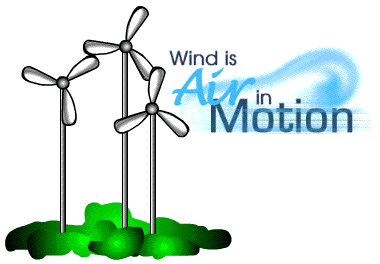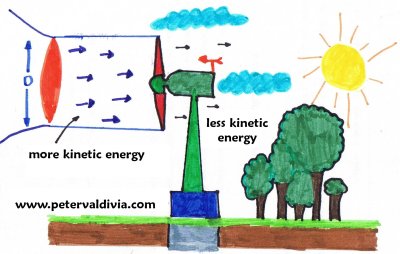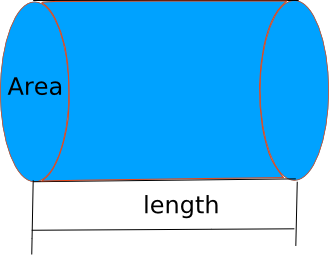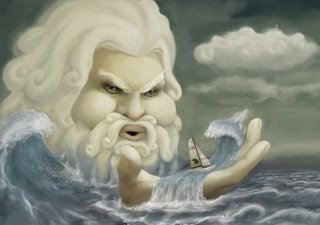Work, Energy and Power
Work:
 Wind energy has traditionally been exploited for thousands of years as a source of energy in ship navigation, wind mills and throughout the last 30 years for producing electricity using wind turbines.
Wind energy has traditionally been exploited for thousands of years as a source of energy in ship navigation, wind mills and throughout the last 30 years for producing electricity using wind turbines.
Wind is a renewable energy because it uses the wind’s energy. It is also a non-polluting energy because it does not produce any green house effect gases.
Fig nº 1
Where does wind come from?
There are two main causes of wind. The first one is that the Earth is always turning around its own axis. The second cause is the fact that the sun does not heat the Earth evenly. The sunrays cover a much greater area at the equator than at the poles. 1 square metre at the equator will be heated a lot more than 1 square metre at the poles.
The hot air rises from the equator and expand towards the poles.
Do you want to produce free ecological electricity. Have a look at this video.

Parts of An Electric generating Windmill
Wind spins the blades on a wind turbine ( number 1 ) just like a large toy pinwheel. The three blades are attached to a hub ( number 2 ) that is connected to a turning shaft. The shaft goes through a gear transmission box ( number 6 ) where the turning speed is increased. Note that the gear connected to the mean shaft is bigger than the one connected to the Generator.
The high speed shaft turns a generator that makes electricity.
If the wind gets too high, the turbine could be damaged, so a brake ( number 4 ) will keep the blades from turning too fast.
Wind speeds usually must be above 20 km/h for a wind turbine to work efficiently. The average production of a turbine is between 40 and 400 kilowatts of electricity.
If a home needs about 3 kw, it means that one turbine could supply more than 100 homes.
Are high winds important?
Energy depends on various factors. For example, in hydropower energy, the higher the step between the dam and the turbine, the more energy the generator will produce. Why? Because the energy we use is the potential energy and that depends on the height.
Energy = M X G X H
Where M is the mass of the water, G is the gravitational constant and H is the height between the dam and the turbine.
In the case of a wind turbine, the energy utilized is the kinetic energy of the wind:
Energy = ½ x M x V²
 So, to start with ” Energy depends on velocity times two. If V = 2 and M = 5 we have E = 0,5 x 5 x 4 = 10. But if the velocity doubles, V = 4 then Energy = 0,5 x 5 x 16 = 40
So, to start with ” Energy depends on velocity times two. If V = 2 and M = 5 we have E = 0,5 x 5 x 4 = 10. But if the velocity doubles, V = 4 then Energy = 0,5 x 5 x 16 = 40
Lets compare both sets of data:
V1 = 2 E1 = 10; V2 = 4 E2 = 50. “We have multiplied velocity by two and we get energy multiplied by 4”.
So increased velocity will increase the energy a lot
We have not finished. Do you think that in both cases M would be the same?

The superb coloured pencil illustration made by my daughter represents the behaviour of the wind, before and after the blades. There is an input wind energy before the blades and an output wind energy after the blades.
The output is less that the input and the difference is the electrical energy given by the turbine ( all this in a ideal case, obviously).
The circular area of wind ( Marked as Area ) swept by the blades is the area available for producing electricity.
Imagine that the blue volume is the air that will pass through the turbine’s blades in any one second. Kinetic energy is also a function of mass. Lets calculate the mass of that volume of air
M = d x V
Where d = density and V the Volume. The volume is the area by the length, so we have:
Mass = Density x volume = d x Area x length = d x ( Πxr²) x L = d x ( Π x (Lb)²) x L
Where Lb represents the length of the blade
On the other hand, the length of the blue volume or the distance covered by the air molecule in one second may be calculated by the physic’s formula; Velocity = Distance / Time; ——–> Distance = Velocity x Time
For a second time, we have ——–> Distance ( L ) = Velocity x 1 second
Replacing Distance in the above formula:
Energy = ½ x M x V² = ½ x [ d x ( Π x (Lb)²) x L] x V² =
½ x [ d x ( Π x (Lb)²) x V] x V² = ½ x d x Π x (Lb)²) x V³ ; if we call ½ x d x Π = Constant = C, we have
Energy = C x Lb² x V³
Energy is dependent on the velocity to the power of 3 (V x V x V). Whooooa!. Consequences:
If the wind speed doubles, the power increases by a factor of eight.
If you increase the length of the blades ( Lb ) by two, the power increases by 4. Nowadays, blades are made very big to take advantage of wind power.( see some of them installed in the Tarifa area)
It is a pity but AEOLUS ( see photo on the left ) takes a rest form time to time, so the wind disappears, and there is another problem.
When Aeolus gets a bit angry with somebody the wind blows too hard and the turbine blades can break or spin so fast they break off.
In these circumstances, the blades are usually “”feathered“” ( see number 3 in fig nº 1 ) reducing the contact with the wind and slow them down. This means we can’t take advantage of really high wind speeds
pinwheel: a toy consisting of vanes of colored paper or plastic that is pinned to a stick and spins when it is pointed into the wind
Hub: The central part from which blades radiate on various devices, as on a fan
Feathered: To turn a blade almost horizontal to reduce friction with air
